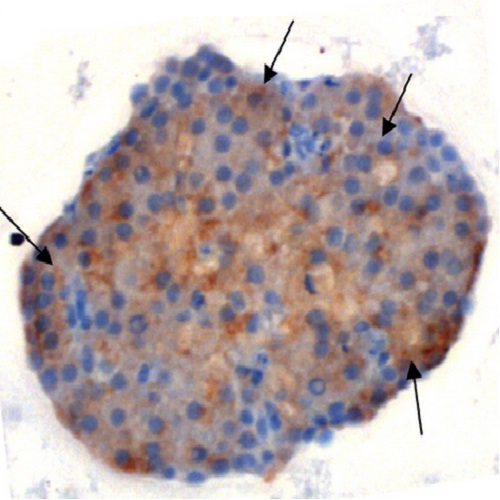Agonist of growth hormone-releasing hormone as a potential effector for survival and proliferation of pancreatic islets.
Therapeutic strategies for transplantation of pancreatic islet cells are urgently needed to expand beta-cell mass by stimulating islet cell proliferation and/or prolonging islet cell survival. Control of the islets by different growth factors provides a potential venue for augmenting beta-cell mass. In the present study, we show the expression of the biologically active splice variant-1 (SV-1) of growth hormone-releasing hormone (GHRH) receptor in rat insulinoma (INS-1) cells as well as in rat and human pancreatic islets. In studies in vitro of INS-1 cells, the GHRH agonist JI-36 caused a significant increase in cell proliferation and a reduction of cell apoptosis. JI-36 increased islet size and glucose-stimulated insulin secretion in isolated rat islets after 48-72 h. At the ultrastructural level, INS-1 cells treated with agonist JI-36 revealed a metabolic active stimulation state with increased cytoplasm. Coincubation with the GHRH antagonist MIA-602 reversed the actions of the agonist JI-36, indicating the specificity of this agonist. In vivo, the function of pancreatic islets was assessed by transplantation of rat islets under the kidney capsule of streptozotocin-induced diabetic non-obese diabetic-severe combined immunodeficiency (NOD-SCID) mice. Islets treated with GHRH agonist JI-36 were able to achieve normoglycemia earlier and more consistently than untreated islets. Furthermore, in contrast to diabetic animals transplanted with untreated islets, insulin response to an i.p. glucose tolerance test (IPGTT) in animals receiving islets treated with agonist Jl-36 was comparable to that of normal healthy mice. In conclusion, our study provides evidence that agonists of GHRH represent a promising pharmacological therapy aimed at promoting islet graft growth and proliferation in diabetic patients.

- Proc. Natl. Acad. Sci. U.S.A. 2010 Jul 13;107(28):12623-8
- 2010
- Medical Biology
- 20616039
- PubMed
Enabled by:
